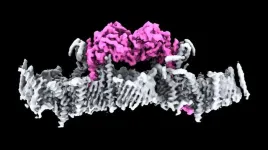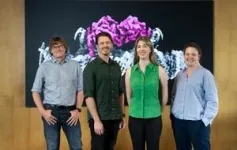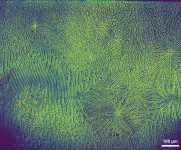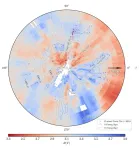(Press-News.org) WEHI researchers have made a huge leap forward in the fight against Parkinson’s disease, solving a decades-long mystery that paves the way for development of new drugs to treat the condition.
First discovered over 20 years ago, PINK1 is a protein directly linked to Parkinson’s disease – the fastest growing neurodegenerative condition in the world. Until now, no one had seen what human PINK1 looks like, how PINK1 attaches to the surface of damaged mitochondria, or how it is switched on.
In a major breakthrough, researchers at the WEHI Parkinson’s Disease Research Centre have determined the first ever structure of human PINK1 bound to mitochondria, in findings published in Science. The work could help find new treatments for the condition that currently has no cure or drug to stop its progression.
At a glance
In a world-first, WEHI researchers have discovered what human PINK1 looks like and how it is activated.
PINK1 is a protein linked to Parkinson’s disease, the second most common neurodegenerative disease after Alzheimer’s. There is no cure for Parkinson’s.
This discovery, published in Science, is a huge leap forward in the fight against Parkinson’s with the hope that it will accelerate the search for a drug to stop the condition.
Parkinson’s disease is insidious, often taking years, sometimes decades to diagnose. Often associated with tremors, there are close to 40 symptoms including cognitive impairment, speech issues, body temperature regulation and vision problems.
In Australia, over 200,000 people live with Parkinson’s and between 10% and 20% have Young Onset Parkinson’s Disease – meaning they are diagnosed under the age of fifty. The impact of Parkinson’s on the Australian economy and healthcare systems is estimated to be over $10 billion each year.
Breakthrough after decades of research
Mitochondria produce energy at a cellular level in all living things, and cells that require a lot of energy can contain hundreds or thousands of mitochondria. The PARK6 gene encodes the PINK1 protein, which supports cell survival by detecting damaged mitochondria and tagging them for removal.
In a healthy person, when mitochondria are damaged, PINK1 gathers on mitochondrial membranes and signals through a small protein called ubiquitin, that the broken mitochondria need to be removed. The PINK1 ubiquitin signal is unique to damaged mitochondria, and when PINK1 is mutated in patients, broken mitochondria accumulate in cells.
Although PINK1 has been linked to Parkinson’s, and in particular Young Onset Parkinson’s Disease, researchers had been unable to visualise it and did not understand how it attaches to mitochondria and is switched on.
Corresponding author on the study and head of WEHI’s Ubiquitin Signalling Division, Professor David Komander, said years of work by his team have unlocked the mystery of what human PINK1 looks like, and how it assembles on mitochondria to be switched on.
“This is a significant milestone for research into Parkinson's. It is incredible to finally see PINK1 and understand how it binds to mitochondria,” said Prof Komander, who is a laboratory head in the WEHI Parkinson’s Disease Research Centre.
“Our structure reveals many new ways to change PINK1, essentially switching it on, which will be life-changing for people with Parkinson’s.”
Hope for future treatments
Lead author on the study, WEHI senior researcher Dr Sylvie Callegari, said PINK1 works in four distinct steps, with the first two steps not been seen before.
First, PINK1 senses mitochondrial damage. Then it attaches to damaged mitochondria. Once attached it tags ubiquitin, which then links to a protein called Parkin so that the damaged mitochondria can be recycled.
“This is the first time we’ve seen human PINK1 docked to the surface of damaged mitochondria and it has uncovered a remarkable array of proteins that act as the docking site. We also saw, for the first time, how mutations present in people with Parkinson’s disease affect human PINK1,” said Dr Callegari.
The idea of using PINK1 as a target for potential drug therapies has long been touted but not yet achieved because the structure of PINK1 and how it attaches to damaged mitochondria were unknown.
The research team hope to use the knowledge to find a drug to slow or stop Parkinson’s in people with a PINK1 mutation.
The link between PINK1 and Parkinson’s
One of the hallmarks of Parkinson’s is the death of brain cells. Around 50 million cells die and are replaced in the human body every minute. But unlike other cells in the body, when brain cells die, the rate at which they are replaced is extremely low.
When mitochondria are damaged, they stop making energy and release toxins into the cell. In a healthy person, the damaged cells are disposed of in a process called mitophagy.
In a person with Parkinson’s and a PINK1 mutation the mitophagy process no longer functions correctly and toxins accumulate in the cell, eventually killing it. Brain cells need a lot of energy and are especially sensitive to this damage.
The study, “Structure of human PINK1 at a mitochondrial TOM-VDAC array”, is published in Science (DOI: 10.1126/science.adu6445).
END
Scientists solve decades-long Parkinson’s mystery
2025-03-13
ELSE PRESS RELEASES FROM THIS DATE:
Spinning, twisted light could power next-generation electronics
2025-03-13
Researchers have advanced a decades-old challenge in the field of organic semiconductors, opening new possibilities for the future of electronics.
The researchers, led by the University of Cambridge and the Eindhoven University of Technology, have created an organic semiconductor that forces electrons to move in a spiral pattern, which could improve the efficiency of OLED displays in television and smartphone screens, or power next-generation computing technologies such as spintronics and quantum computing.
The semiconductor they developed emits circularly polarised ...
A planetary boundary for geological resources: Limits of regional water availability
2025-03-13
Geological resources such as critical metals and minerals, essential for the diffusion of technologies such as renewable energy and energy storage towards a decarbonized society, are indispensable for supporting modern life in the form of various products and services. Their demand is expected to increase in the coming years owing to global population as well as economic growth. Thus far, scientists and policymakers have primarily discussed geological resource availability from the viewpoint of reserves and resources in the ecosphere and technosphere. However, resources such as ...
Astronomy’s dirty window to space
2025-03-13
When we observe distant celestial objects, there is a possible catch: Is that star I am observing really as reddish as it appears? Or does the star merely look reddish, since its light has had to travel through a cloud of cosmic dust to reach our telescope? For accurate observations, astronomers need to know the amount of dust between them and their distant targets. Not only does dust make objects appear reddish (“reddening”), it also makes them appear fainter than they really are (“extinction”). It’s like we are looking out into space through a dirty ...
New study reveals young, active patients who have total knee replacements are unlikely to need revision surgery in their lifetime
2025-03-13
A 40-year study by Hospital for Special Surgery (HSS) researchers has found that active young adults who underwent total knee replacement were unlikely to require knee replacement revision in their lifetime, according to a new study shared today in a podium presentation at the American Academy of Orthopaedic Surgeons 2025 Annual Meeting.1
“As an increasing number of younger adults in their 40s and 50s consider total knee replacement, many wonder how long knee implants last before requiring a revision procedure,” ...
Thinking outside the box: Uncovering a novel approach to brainwave monitoring
2025-03-13
ROCHESTER, Minnesota — Mayo Clinic researchers have found a new way to more precisely detect and monitor brain cell activity during deep brain stimulation, a common treatment for movement disorders such as Parkinson's disease and tremor. This precision may help doctors adjust electrode placement and stimulation in real time, providing better, more personalized care for patients receiving the surgical procedure. The study is published in the Journal of Neurophysiology.
Deep brain stimulation (DBS) involves implanting electrodes in the brain that emit electrical pulses to alleviate symptoms. The electrodes remain inside the brain connected to a battery implanted near ...
Combination immunotherapy before surgery may increase survival in people with head and neck cancer
2025-03-13
CHAPEL HILL, North Carolina—Researchers conducting a clinical trial of immunotherapy drugs for people with head and neck squamous cell carcinomas (HNSCCs) found that patients responded better to a combination of two immunotherapies than patients who received just one immunotherapy drug.
The scientists also analyzed immune cells in each person’s tumor after one month of immunotherapy to see which type of immune cells were activated to fight their cancer, suggesting that some of the cells and targets they identified could help individualize treatment benefit.
The findings appeared March 13, 2025 in Cancer Cell.
HNSCCs occur in the oral cavity, pharynx, hypopharynx, larynx, nasal ...
MIT engineers turn skin cells directly into neurons for cell therapy
2025-03-13
CAMBRIDGE, MA -- Converting one type of cell to another — for example, a skin cell to a neuron — can be done through a process that requires the skin cell to be induced into a “pluripotent” stem cell, then differentiated into a neuron. Researchers at MIT have now devised a simplified process that bypasses the stem cell stage, converting a skin cell directly into a neuron.
Working with mouse cells, the researchers developed a conversion method that is highly efficient and can produce more than 10 neurons from a single skin cell. If replicated in human ...
High sugar-sweetened beverage intake and oral cavity cancer in smoking and nonsmoking women
2025-03-13
About The Study: High sugar-sweetened beverage intake was associated with a significantly increased risk of oral cavity cancer in women, regardless of smoking or drinking habits, yet with low baseline risk in this study. Additional studies are needed in larger cohorts, including males, to validate the impact of these findings.
Corresponding Author: To contact the corresponding author, Brittany Barber, MD, MSc, email bbarber1@uw.edu.
To access the embargoed study: Visit our For The Media website at this link https://media.jamanetwork.com/
(doi:10.1001/jamaoto.2024.5252)
Editor’s ...
Area socioeconomic status, vaccination access, and female HPV vaccination
2025-03-13
About The Study: In this cross-sectional study of area deprivation, vaccination access, and human papillomavirus (HPV) vaccination status in Osaka City, Japan, higher socioeconomic status and higher medical facility access were associated with higher cumulative HPV vaccination uptake. These findings suggest that further strategies, including a socioecologic approach, are needed to increase HPV vaccination and reduce disparities in uptake.
Corresponding Author: To contact the corresponding ...
Checking PSA levels too soon after prostate cancer surgery can lead to overtreatment
2025-03-13
After surgical removal of the prostate to treat prostate cancer, clinicians monitor Prostate Specific Antigen (PSA) levels. Persistently elevated PSA levels indicate residual cancer and are linked to worse outcomes. But in a paper published in JAMA Oncology, Mass General Brigham researchers found that the current standard monitoring time of one-and-a-half to two months following surgery is too short to accurately identify recurrence and inform treatment decisions. Rather, PSA levels should be measured for at least three months to avoid overtreatment.
“Checking ...





